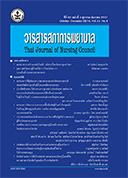Impact of Adjusted Cardiopulmonary Resuscitation Process on Return of Vital Signs and Spontaneous Circulation in Cardiac Arrest Patients in Emergency Unit
Keywords:
cardiopulmonary resuscitation, cardiac arrest patients, return of vital signs, return of spontaneous circulation, survival, trauma and emergency unitAbstract
Objective: To study how effectively an adjusted cardiopulmonary resuscitation process (CPR)
could restore vital signs and spontaneous circulation in cardiac arrest patients treated in an emergency
unit.
Design: Quasi-experimental with a two group design.
Methodology:Thesampleconsistedof60cardiacarrestpatientsreceivingCPRinanemergency
unit of Kamphaengphet Hospital. The participants were divided equally and assigned to an unadjusted
CPR group and an adjusted CPR group. Data were collected through the patients’ medical records
and the CPR speeds recorded by the emergency unit’s video. The patients’ baseline characteristics
were analysed using descriptive statistics. The CPR time differences were compared using an
independent T-test, whilst the patients’ rates of return of vital signs and of survival were compared
using an Exact Probability test.
Results: There was no signifcant difference in baseline characteristics between the two groups.
However, the CPR process conducted by the adjusted CPR group was signifcantly faster than that
by the unadjusted CPR group. In the adjusted CPR group, chest compression, defribillation, tracheal
intubation, and adrenalin injection were completed in a signifcantly shorter time (p < 0.05) than in
the unadjusted CPR group. In addition, the patients in the adjusted CPR group displayed signifcantly
higher rates of return of vital signs and of spontaneous circulation (hence survival) than their unadjusted
CPR counterparts did (p < 0.05).
Recommendations: Adjustment of the CPR process by defning the working area, building
good teamwork, and systematically managing the equipment and medications can enhance the
effectiveness of CPR. With a faster speed, the adjusted CPR process is likely to increase cardiac
arrest patients’ chance of regaining vital signs and survival. It is recommended, therefore, that the
concept of CPR process adjustment be applied to emergency unit management.
Downloads
References
1. American Heart Association. About cardiac arrest.[serial online] 2017 Mar [Cited 2017 Nov 20];
Available from: URL: https://www.heart.org/HEARTORG/Conditions/More/CardiacArrest/About-Cardiac-Arrest_UCM_ 307905_Article.jsp#.W1wcLdR95kg.
2. Boonmak P. BLS and ACLS survey concepts. In: Krishnarangsan S, Santatianan R, SaeLi R, editor.ACLS Provider manual 2015. Bangkok: Panjamit Printing; 2016. P. 41-5. (in Thai)
3. Thai Resuscitation Council. The Heart Association 0f Thailand under the Royal Patronage. Highlights of 2015 Guidelines for CPR. Bangkok: Panjamit Printing; 2015. (in Thai)
4. Donoghue AJ, Abella BS, Merchant M, Praestgaard A, Topjian A, Berg RA, et al. Cardiopulmonary resuscitation for in-hospital events in the emergency department: A comparison of adult and pediatric outcomes and care processes. Resuscitation 2015;92:94-100.
5. Haghighi SHO, Vahdati SS, Mahmoudie T, Majd PS, Mirza-Aghazadeh-Attari M. Outcomes of cardiopulmonary resuscitation in the emergency department. JEPT 2017; 3(2):49-52.
6. BanathongP,PongpanitP,PrakrobN.Careofcardiac arrest patient admitted in accidental and Emergency
Department at JainadNarendra Hospital. [serial online]2017;[Cited2017Dec10];Availablefrom: https://www.chainathospital.org/chainatweb/assets/research/research1.pdf.
7. Chanchayanon T, Suwanwong P, Nimmaanrat S. Outcome of in-hospital cardiopulmonary resuscitation and factors affecting the outcome at Songklanagarind Hospital. Songklanagarind Medical Journal 2011; 29:39-49. (in Thai)
8. Kunkongkaphan M, Janphan T. Characteristics of cardiac arrest patients and factors associated with return of spontaneous circulationsuccess at the emergency department Maesai Hospital Chiang Rai province. Nursing Public Health and Education Journal 2015;1:53-66. (in Thai)
9.Emergency Department. KamphaengPhet Hospital. Unitprofle2017.KamphaengPhet:KamphaengPhet Hospital; 2017. (in Thai)
10.Department of medical services. Guideline for ER service delivery. [serial online]. 2016; [Cited 2017 Dec 10]; Available from: https://www.dms.moph.go.th/dms2559/download/ERService Delivery.pdfGuidelineforERservicedelivery.(inThai)
11.Hunziker S, Johansson AC, Tschan F, Semmer NK, Rock L, Howell MD, et al. Teamwork and leadership in cardiopulmonary resuscitation. JACC 2011; 57(24): 2381–8.
12.Donoghue AJ, Hsieh T, Myers S, Mak A, Sutton R,Nadkarni V. Videographic assessment of cardiopulmonary resuscitation quality in the pediatric emergency department. Resuscitation 2015; 91:19–25.
13.Riyapan S. Apply LEAN principle to crowded emergency room. [serial online]. 2017; [Cited 2017 Oct 3]; Available from: https://www.si.mahidol.ac.th/th/division/soqd/admin/714_18_2.pdf. (in Thai)
14.Yatongchai N. Development of rescue team in emergency department. [serial online]. 2018;[Cited 2018 Feb 2]; Available from: https://www.med.swu.ac.th/emergencymed/images/ER/ KMCPR-1_2561_compressed.pdf. (in Thai)
15.Chen S, Li W, Zhang Z, Min H, Li H, Wang H, et al. Evaluating the quality of cardiopulmonary resuscitation in the emergency department by realtime video recording system. PLoS ONE 2015; Oct 2;10-20.74
16.Fredriksson M, Aune S, Thoren AB. In-hospital cardiac arrest-an Utstein style report of seven years experience from the Sahlgrenska University Hospital. Resuscitation 2006; 68:351-8.
17.Cooper S, Janghorbani M, Cooper G. A decade of in-hospital resuscitation: Outcomes and prediction of survival. Resuscitation 2006; 68:231-7.
18.Isenberg DL, Bissell R. Dose advanced life support provide benefts to patients?: A literature review.
Prehosp Disaster Med 2005; 20:265-70.
19.Andersen LW, Kurth T, Chase M, Berg KM, Cocchi MN, Callaway C, et al. Early administration of epinephrine (adrenaline) in patients with cardiac arrest with initial shockable rhythm in hospital: Propensity score matched analysis. BMJ 2016;353:i1577.








